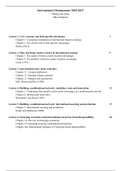International Management 2018-2019
Tilburg University
Milou Nijskens
Lecture 1. Core concepts and firm-specific advantages 1
Chapter 1. Conceptual foundation of international business strategy
Chapter 2. The critical role of firm-specific advantages
Benito (2015)
Lecture 2. Host and home country factors in international strategy 5
Chapter 3. The nature of home country location advantages
Chapter 4. The problem with host country location advantages
Grant (1991)
Lecture 3. International entry mode strategies 8
Chapter 11. Foreign distributors
Chapter 12. Strategic alliance partners
Chapter 13. Mergers and acquisitions
Hill, Hwang and Kim (1990)
Lecture 4. Building a multinational network: subsidiary roles and innovation 13
Chapter 5. Combining firm-specific and location advantages in a multinational network
Chapter 6. International innovation
Birkinshaw and Hood (1998)
Lecture 5. Building a multinational network: international sourcing and production 17
Chapter 7. International sourcing and production
Kedia and Mukherjee (2009)
Lecture 6. Emerging economies and international Corporate Social Responsibility 20
Chapter 14. The role of emerging economies
Chapter 15. Emerging economy multinational enterprises
Chapter 16a. International strategies of Corporate Social Responsibility
, Lecture 1. Core concepts and firm-specific advantages
Some (Friedman) say international does not matter anymore because communication costs decline,
boundaries are irrelevant and everyone should modernize. Paradox of knowledge: revealing knowledge
decreases its value, but not saying anything won’t lead to sellers. So, there is information asymmetry
between buyer and seller. However, some say international matters because we act on stereotyping and
differences remain influential. Looking at the Walmart case the following can be concluded:
a successful business model in the USE, isn’t necessary great in Western Europe.
International business strategy: effectively and efficiently matching a multinational enterprise’s internal
strengths (relative to competitors) with the opportunities and challenges found in geographically
dispersed environments that cross international borders (while overcoming the disadvantages of being a
foreign company). Elements:
Why Where What How
Natural resource seeking (Diamond mine) Attractiveness of Marketing, sales, Export, licensing,
Market seeking host country looking manufacturing, franchising, joint
Strategic asset seeking (Silicon Valley) at cultural, economic, purchasing, R&D, venture, alliance,
Efficiency seeking (lower costs) administrative and extraction etc. Foreign Direct
spatial distance. Investment (FDI)
When licensing, the company licenses to a third party to produce the product in the host environment (e.g.
Coca Cola). There are two types of FDI’s: Brownfield and Greenfield. A Brownfield foreign direct
investment is changing an existing plant by upgrading or modification. Hereby, the company is not
looking for a partner, but does it alone. Therefore, acquisition is a Brownfield foreign direct investment.
A Greenfield foreign investment is used when there are no plants.
Firm-specific advantage (core competence): (1) firm is a portfolio of core competencies, higher-order
FSAs, i.e. the firm’s routines and recombination capabilities. (2) A core competence ultimately takes the
form of: shared knowledge, organized into routines, and the ability to integrate multiple technologies,
reflecting the recombination of internal resources. A core competence should:
Provide access to a wide variety Contribute significantly to Be difficult for
of markets; “travel” (1) the end-product benefits (2) competitors to imitate (3)
Market: products appeal to local Brand name and/ or product Product features, brand
consumer taste and comply with are competitive in local name
local standards. markets.
Efficiency: production technologies can be Efficiency gains from local Technology, intellectual
transferred to other production production should be property (IP) protection
locations. considerable.
Resource: the firm’s technologies are Local resource endowments Protection against
compatible with the local should justify the investment. appropriation
resources.
Strategic the firm’s knowledge is Local knowledge should be IP protection, prevention
asset:
compatible with the local rich and deep enough to of tacit knowledge leakage
knowledge justify investment.
International Management | Nijskens, M.W.G. 1
, The MNE (multinational enterprise) resource base: internationalizing must rest on ‘unique resources’:
- Physical resources: natural resources, buildings, plant equipment;
- Financial resources: equity and loan capital;
- Human resources: individuals and teams, entrepreneurial and operational skills;
- Upstream knowledge: sourcing knowledge, product and process-related technological knowledge.
E.g. the ability to source efficiently: production at lowest possible price;
- Downstream knowledge: marketing, sales, distribution and after sales service;
- Administrative knowledge: organizational structure, culture and systems;
- Reputational resources: brand names, reputation for honest business dealings;
Resource bases differ greatly per company. Shell needs its locations (oil) whereas Coca Cola relies on its
brand name.
Conceptual foundations of international business strategy
1. Internationally transferable (or non-location bound) firm-specific advantages;
2. Non-transferable (location bound) firm-specific advantages;
3. Location advantages;
4. Investment in – and value creation through – recombination;
5. Complementary resources of external actors;
6. Liability of foreignness: bounded rationality;
7. Liability of foreignness: bounded reliability;
8. (Advantages of foreignness: cultural attraction and arbitraging)
(1) Transferable, non-location bound FSAs: these advantages are important but they do not make you
successful up front due to the paradox: when the advantage consists of easily codifiable knowledge (e.g.
handbook or patent), then it can be cheaply transferred abroad, but it can also be easily imitated. Other
examples are financial resources, machinery and solid materials.
Successfully transferring ‘difficult firm-specific advantages’ abroad will generate competitive
advantage. For example, Toyota’s network is almost symbolic in Japan. Thumbs up coke is famous in
India but won’t be successful in Europe.
(2) Not transferable, location-bound FSAs: the more transferable assets and tacit knowledge, the better
as it is more difficult to imitate. These can be separated into four categories:
- Stand-alone resources linked to location advantages;
- Local marketing knowledge and reputational resources such as brand reputation in home country;
- Local best practises (i.e. routines) such as incentive systems or buyer-supplier relations (Toyota,
might not work abroad);
- Domestic recombination capability (legislation) which could be a limitation e.g. not being allowed
to conduct a particular type of research or market a product on a typical way.
(3) Location advantages:
- Entire set of strength of a location, and accessible by (all) firms in that location;
- Should always be assessed relative to the strengths of other locations.
E.g. in San Francisco there are many employees with many capabilities or the Diamond mine where
diamond can be found. These are not firm-specific: ‘in principle’ available for all firms (but firm must act
to enjoy these advantages).
International Management | Nijskens, M.W.G. 2






